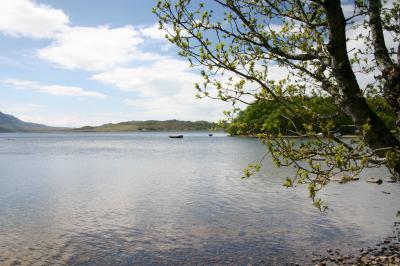Morag of Loch Morar Sightings Discovered

Loch Morar, Lochaber.
Researchers at the University of Edinburgh have discovered accounts dating back more than one hundred years of Morag of Loch Morar. The descriptions paint a conflicting view of the monster, who is reputed to inhabit the Loch in the remote Lochaber area of the Highlands.
One account describes her as a mermaid-like creature with flowing hair, while the other describes her as a grim reaper whose sighting was a precursor to death. The accounts were documented by Alexander Carmichael in 1902, who was a prolific gatherer of folklore and later became a figurehead in the celtic artistic movement. He wrote the descriptions in Gaelic and is thought to only have spent a few days in the area interviewing locals, not getting a glimpse of the elusive Morag himself.
In the first text, Carmichael states: “Morag is always seen before a death and before a drowning.”
A second text reads: “There is a creature in Loch Morar and she is called Morag. She is never seen save when one of the hereditary people of the place dies. The last time she was seen was when Aeneas Macdonnell died in 1898. The Morag is peculiar to Loch Morar. She is seen in broad daylight and by many persons, including church persons. She appears in a black heap or ball slowing and deliberately rising in the water and moving along like a boat waterlogged.”
A final description, penned by Mr Carmichael at a later date, retains Morag’s association with death, but sees her take on more human characteristics. He wrote: “Like the other water deities, she is half-human half-fish. The lower portions of her body are in the form of a grilse and the upper in the form of a small woman of highly developed breasts with long flowing yellow hair falling down her snow-white back and breast. She is represented as being fair, beautiful and very timid and never seen, save when one of the Morar family dies or when the clan falls in battle. The Morag has often brought out of their houses at night the people living along the shores of the lake … causing much anxiety to the men and much sore weeping to the women.”
Dr Donald Stewart, a senior researcher on the project, discovered the texts while leafing through a “mad mixture” of folklore collected by Carmichael over 50 years. “People make sense of it in different ways, depending on who sees it, what they’re feeling at the time and how the story comes down from tradition afterwards,” he said.
“I think the texts are pretty exciting. They give us a window back to how people saw this monster well over 100 years ago. They’re the first reported sightings that we have.”
In other monster-related news, the hunt for the Loch Ness Monster is about to celebrate its 80th anniversary. Said to have been spotted in 1933 by Aldie Mackay, the sighting of the monster put Loch Ness on the map and created a global media and tourism phenomenon that continues to this day. The tiny lochside village of Drumnadrochit receives around 300,000 visitors each year, with visitor numbers spiking following reported sightings. Loch Ness Monster tourism is estimated to be worth around £30 million – spent on hotels and B&Bs, boat trips, food and monster-branded merchandise.
_______
You can read our information pages about Morag, the Loch Ness Monster and other Scottish monsters here.


Watson described it. However, my father has seen it, and all that flowing hair stuff is rubbish! As far as he and others who have seen it are concerned, it's far more seal like, though that's only a rough comparison.